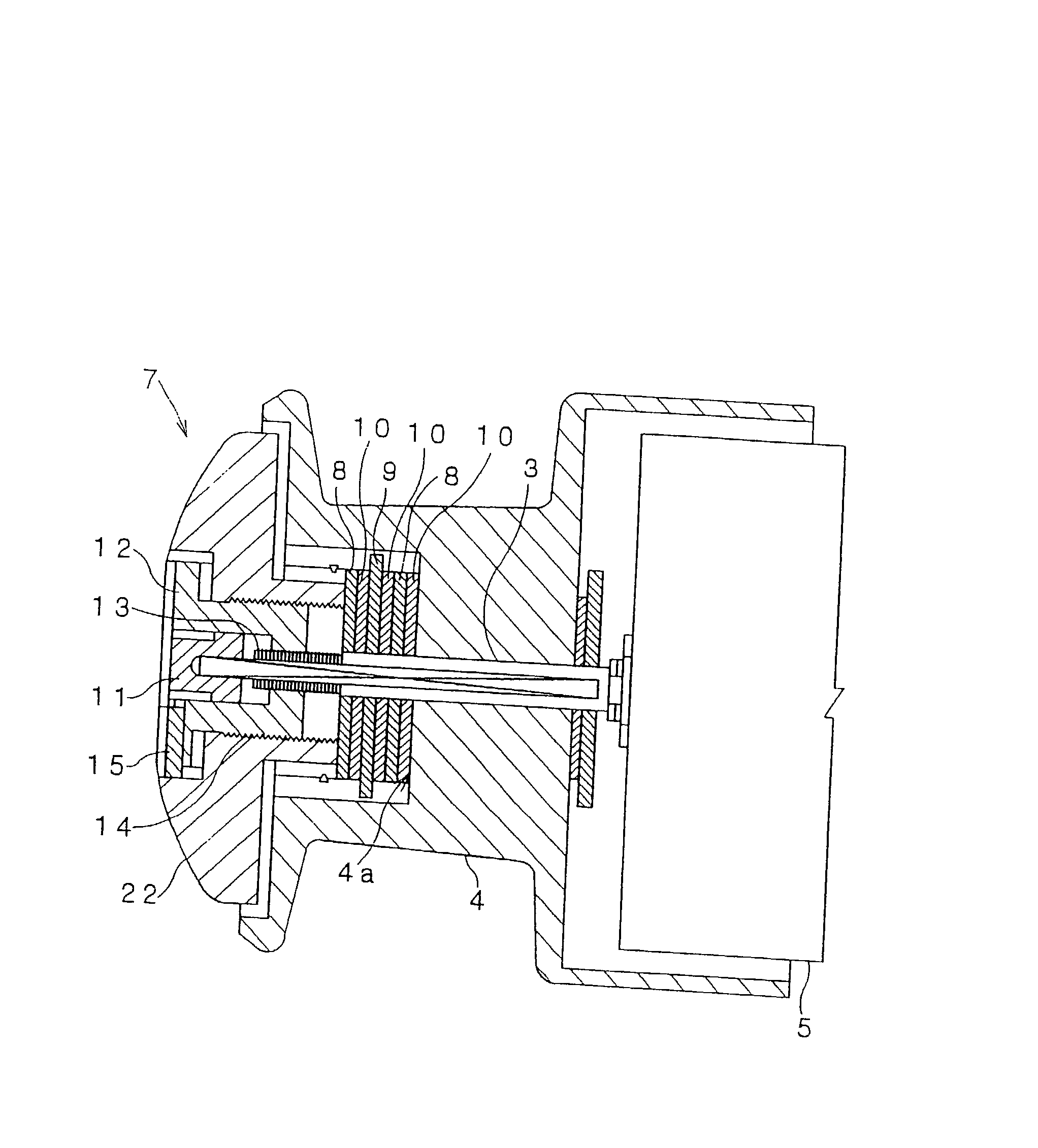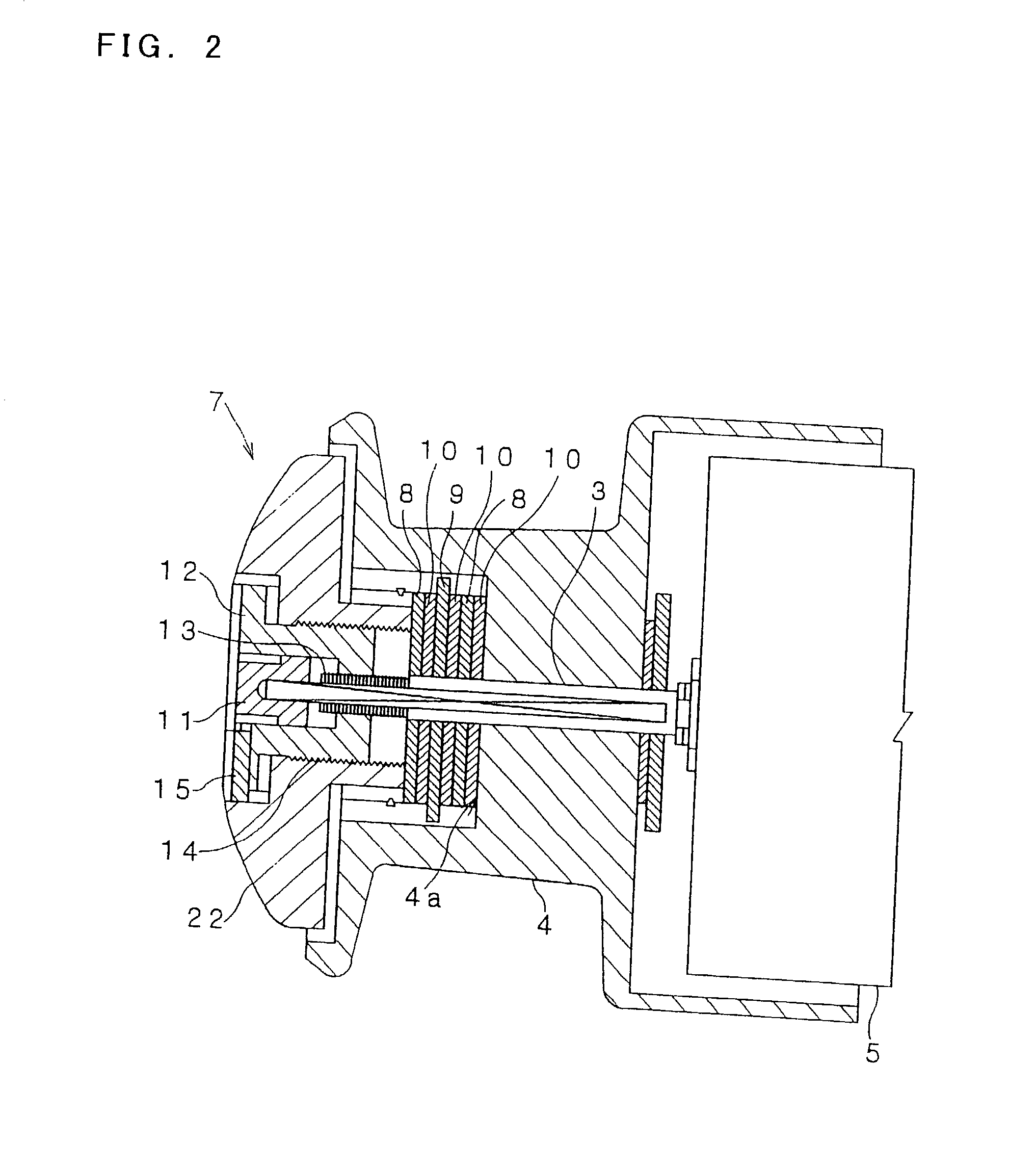[0012] The expanded graphite used for the fishing reel's drag washer of the present invention is produced as follows. For example,
flake graphite is subjected to
acid treatment by using
sulfuric acid and
oxidizing agent to thereby produce acidized graphite, first, and then heated rapidly to approximately 1,000.degree. C. so as to be expanded 100-300 times. Thereafter, the expanded graphite is ground in powdery form by using a granulator. Then, after the expanded graphite is formed into a felt form or a sheet form having a
bulk density of 0.05-1.5 g / cm.sup.3, the expanded graphite of felt form or sheet form is further ground in powdery form by using any proper high-speed mill type of grinder. Preferably, the powders of either of the felt and sheet have a bulk density of 0.05-1.5 g / cm.sup.3 and a mean particle size of 150-250 .mu.m. The expanded graphite ground into powdery form by the granulating method is easily delaminated, so that it is uniformly mixed with the heat-resistant reinforcing material and the heat-resistant binder with ease. The expanded graphite obtained when the felt of a bulk density of less than 0.05 g / cm.sup.3 is ground becomes so bulky that it is hard to deal with. On the other hand, the expanded graphite obtained when the sheet of a bulk density of more than 1.5 g / cm.sup.3 is ground is formed in the granular form, so that the characteristics of the expanded graphite itself are impaired.
[0014] The
aramid fiber pulp of para-series used as the heat-resistant reinforcing fiber mentioned above is preferably 3.0 m.sup.2 / g or more in specific surface area, or further preferably 5-20 m.sup.2 / g. The fiber length of 0.9-2.0 mm affords good dispersibility and high filler retention of 50-70%. The specific surface area of less than 3.0 m.sup.2 / g is not good enough to provide the reinforcing effect of the expanded graphite and as a result, the strength of the sheet obtained is reduced.
[0015] Thermosetting resins are preferably used as the heat-resistant binder for bonding the expanded graphite and the heat-resistant reinforcing fiber. Particularly preferable are
phenol resin,
polyester resin, and
epoxy resin. Among others, fine-grained
phenol resin having a mean molecular weight of not less than 5,000 and a mean particle size of not more than 20 .mu.m which affords excellent sliding properties is of preferable. This thermosetting resin is easily soluble in
solvent and is able to be uniformly dispersed in between the expanded graphite powders and the fiber pulps.
[0023] A prescribed amount of
mixed solution, in which the
raw material concentration of 1.0-2.0% comprising expanded graphite, heat-resistant reinforcing fiber and heat-resistant binder is dissolved, is poured into a tank having a wire cloth of a given size. Then, the
mixed solution is diluted by an equal amount of water and is dispersed uniformly. Thereafter, it is dehydrated (
dehydration process) to obtain a sheet of
water content of 50-60%. Then, with the sheet sandwiched between felts, the sheet was compressed by a press, for further
dehydration. Then, the sheet is put in an oven of 100-120.degree. C. and dried therein. Thereafter, the sheet is passed through the calendar roll and heat-treated at 150-250.degree. C. for 0.5-1.0 hour to cure the heat-resistant binder, so that the sheet is adjusted to 0.7-1.2 mm, or preferably 0.7-1.0 mm, in thickness and 0.8-1.2 g / cm.sup.3 or preferably 0.9-1.1 g / cm.sup.3, in bulk density. The sheet of a thickness of less than 0.7 mm would not develop satisfactory strength for the drag washer. On the other hand, the sheet of a thickness of more than 1.2 mm would provide an increased friction resistance, resulting in providing inadequate drag force. The sheet of a bulk density of less than 0.8 g / cm.sup.3 would not develop satisfactory strength for the drag washer, as in the case of the thickness being reduced. On the other hand, the sheet of a bulk density of more than 1.2 g / cm.sup.3 would undergo a lot of changes in coefficient of dynamic friction and the
coefficient of friction would then be apt to increase with time and, as a result of this, the sheet could not be practically used as the drag washer for an
extended time period. As a result of the bulk density being within this specific range, adequate voids are produced. When the drag washer formed from the sheet having this specific bulk density is fitted to a fishing reel, there is provided the
advantage that when
lubricant such as
grease is applied to the drag washer, the
lubricant is charged in the voids and, as a result of this, reduction in
lubrication caused by
permeation of water and sea water in the drag is prevented. It is to be noted that this process is suitable for production of a single piece of sheet.
[0025] The sheet thus produced is formed into any desirable size and shape by
punching, to form the drag washers applicable to all types of fishing reels for a variety of fish
ranging from a small-sized fish fishing reel to a large-sized fish. Also, the sheet thus produced enables the fishing reel's drag washer to be produced at reduced costs, as compared with the conventional material used for the drag washer.
 Login to View More
Login to View More  Login to View More
Login to View More 


